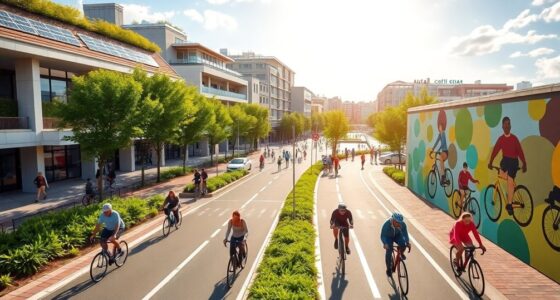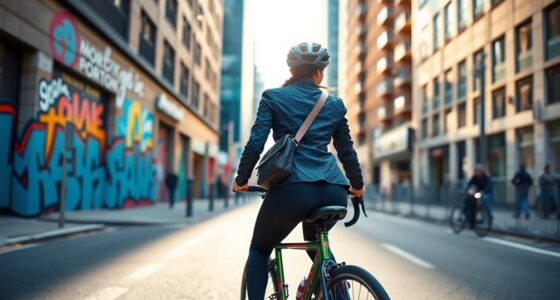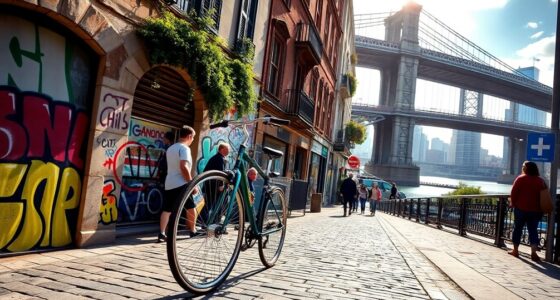Navigating city traffic as an urban cyclist requires you to wear essential safety gear, like a sturdy helmet and reflective clothing. Always adhere to traffic laws, signal your turns, and use bike lanes when possible. Stay aware of your surroundings and regularly maintain your bike for optimal performance. Plan your routes carefully to avoid congested areas and ensure you're visible to others. Ready to discover more tips that can keep you safe and efficient on the road?
Key Takeaways
- Obey all traffic signals and signs to ensure safe navigation and predictability in city traffic.
- Use designated bike lanes whenever available and ride in the same direction as traffic.
- Stay visible by wearing bright, reflective clothing and using front and rear lights, even during the day.
- Plan routes that avoid high-traffic areas and utilize bike-friendly paths to minimize confrontation with vehicles.
- Regularly scan your surroundings for obstacles and establish eye contact with drivers at intersections to enhance safety.
Essential Safety Gear for Urban Cyclists
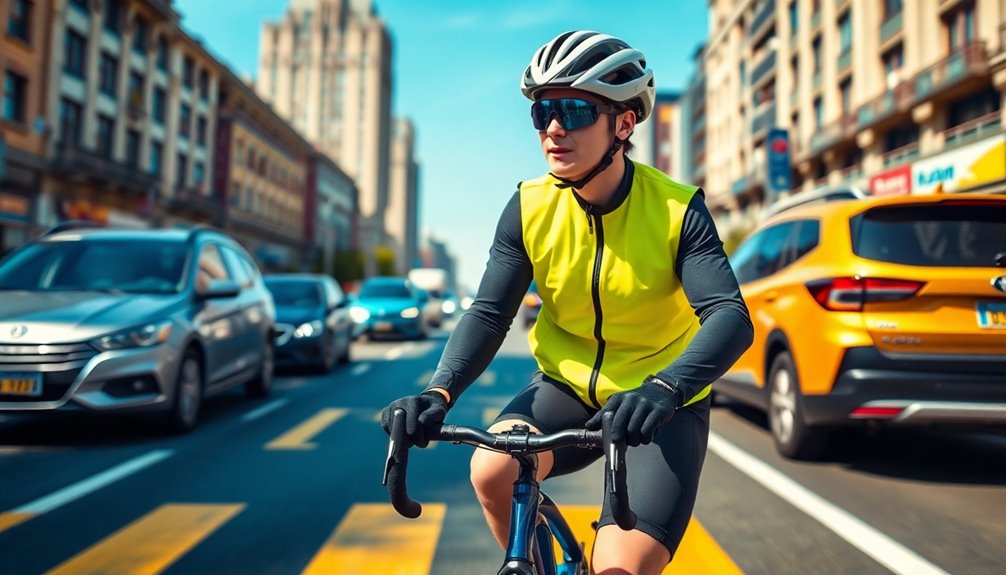
When you hit the urban streets on your bike, having the right safety gear can make all the difference in protecting yourself.
Start with a sturdy helmet that meets safety standards; it's your first line of defense. Equip your bike with front and rear lights for visibility, especially during low-light conditions.
Wear reflective clothing to enhance your presence on the road, while knee and elbow pads provide extra protection in case of falls.
Don't forget mirrors to keep an eye on traffic without turning your head. Accessories like gloves and padded shorts can improve comfort, making your ride more enjoyable.
Lastly, consider a first-aid kit for emergencies, ensuring you're ready for anything the city throws your way.
Adhering to Traffic Laws
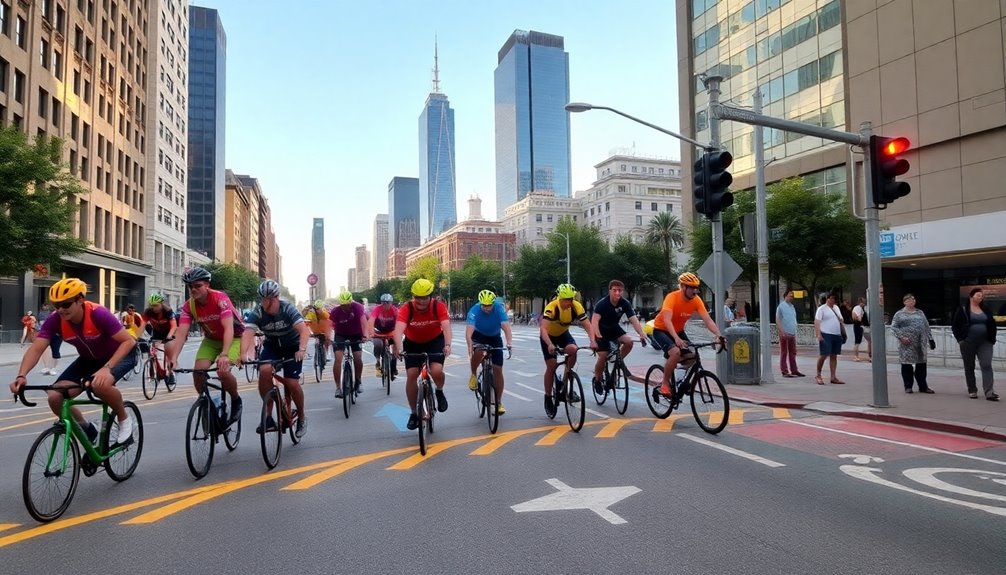
While navigating city streets on your bike, it's crucial to adhere to traffic laws to ensure your safety and that of others.
Always obey traffic signals and signs, and use bike lanes when available, riding in the same direction as traffic. If you're moving slowly, keep to the far right side of the lane unless avoiding hazards.
Always follow traffic signals and use bike lanes, riding with traffic and staying to the right when moving slowly.
Remember to signal your turns or lane changes with clear hand signals, and yield to pedestrians and vehicles when required.
Familiarize yourself with local regulations, as some areas may restrict sidewalk cycling or have specific age laws.
Importance of Regular Bike Maintenance

Regular bike maintenance is essential not just for your safety, but also for enhancing your overall cycling experience.
When you keep your bike in good shape, vital components like brakes and tires function properly, significantly lowering the risk of accidents. A well-maintained bike rides smoother and performs better, making your commutes more efficient.
Plus, taking care of your bike helps the environment by extending its lifespan and reducing waste. Regular checks can catch issues early, saving you money on costly repairs down the line. Additionally, essential oil safety practices can help ensure that any oil-based cleaners you use on your bike don't cause harm to the environment.
With convenient options like mobile bike repair services, maintaining your bike is easier than ever.
Staying Aware of Your Surroundings
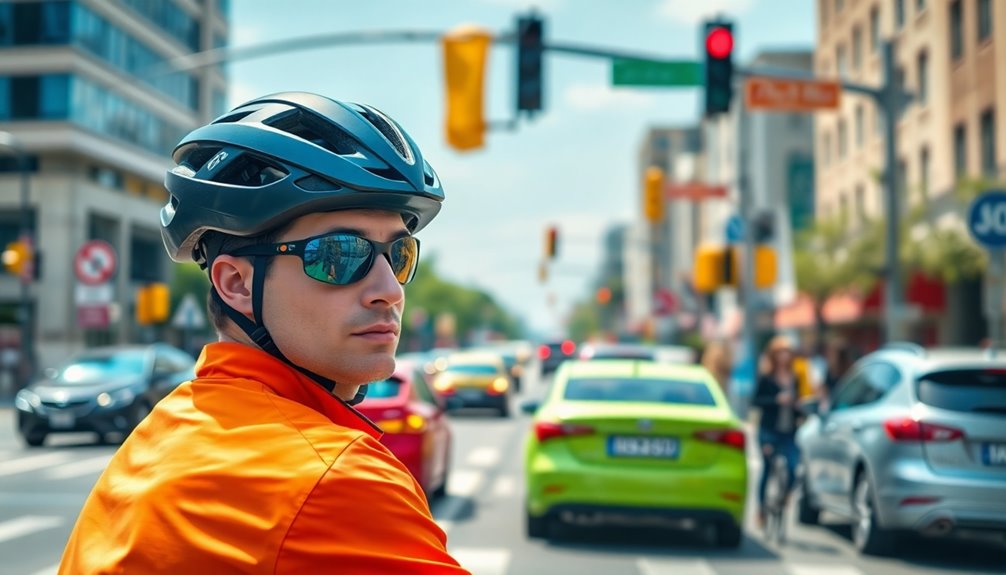
How can you stay safe on your bike in busy urban environments? Staying aware of your surroundings is crucial.
Use bike lights to enhance visibility, even in daylight, and wear bright, reflective clothing. Ride predictably in a straight line and position yourself in the center of the lane when necessary to avoid being squeezed by vehicles.
Always monitor traffic flow and watch for pedestrians stepping into the street. Regularly scan for obstacles like potholes or debris, and use hand signals to communicate your intentions clearly.
Establish eye contact with drivers at intersections, and avoid lingering in their blind spots. By maintaining situational awareness, you can anticipate hazards and react effectively, keeping yourself safe while navigating city streets.
Effective Route Planning Techniques
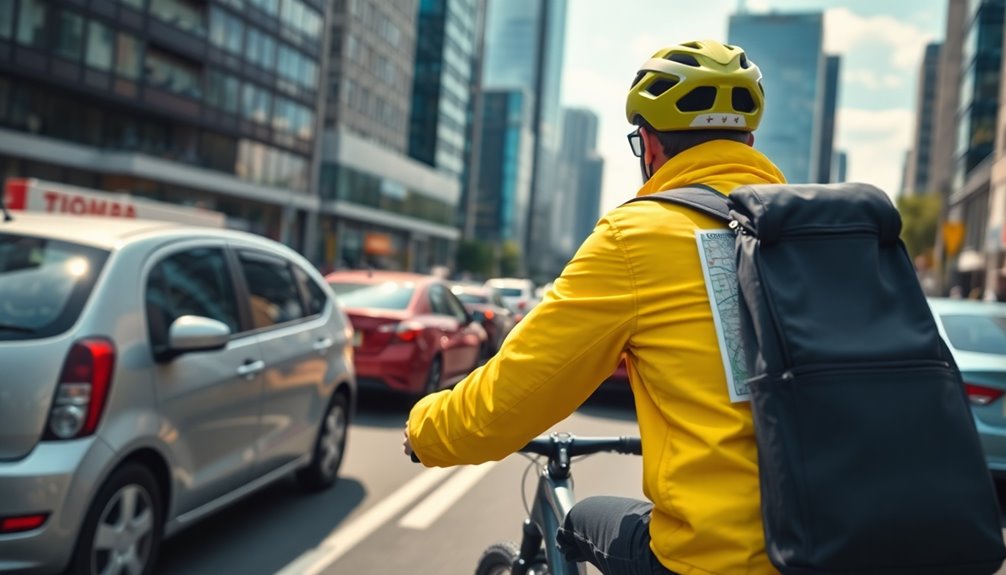
Staying aware of your surroundings is important, but effective route planning can significantly enhance your safety and enjoyment while cycling in urban areas.
First, identify bike-friendly paths using maps to locate designated lanes and trails. Avoid high-traffic areas by planning routes that steer clear of congested roads.
Utilize technology like route planning apps for real-time traffic updates and optimization. Consider the terrain; adjust your routes based on hills and gradients for a smoother ride.
Incorporate shortcuts such as footpaths or bike trails to bypass busy intersections. Lastly, familiarize yourself with local maps to ensure you're aware of bike-friendly infrastructure, making your ride safer and more pleasant.
Practicing Good Cycling Etiquette
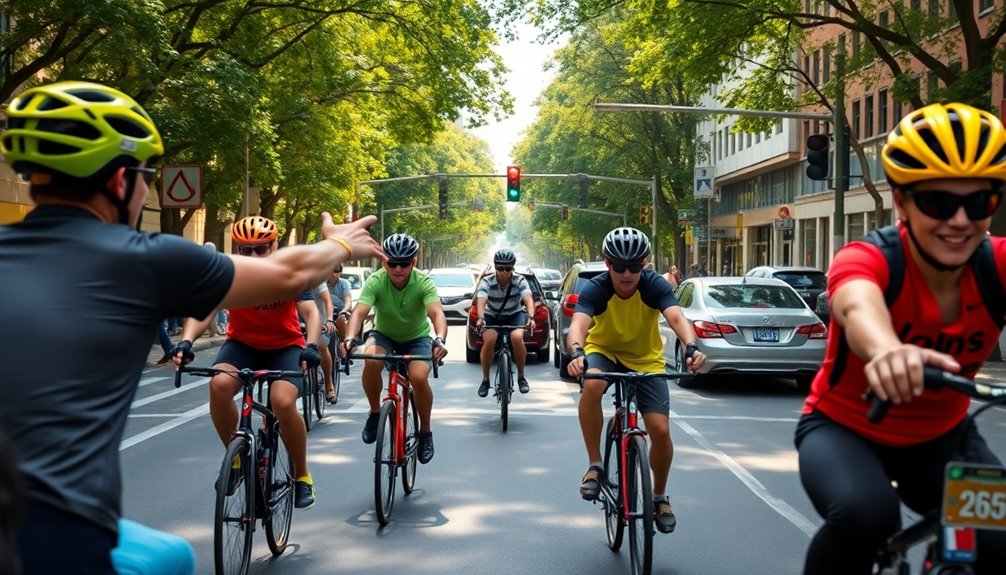
Why is practicing good cycling etiquette crucial for urban riders? It ensures safety for you and those around you.
When riding in a group, never go more than two abreast to keep traffic flowing. Stay close, ideally no more than six inches apart, and use hand signals to communicate turns or obstacles.
Ride predictably by maintaining a straight line and signaling changes; this helps others anticipate your movements. Always yield to pedestrians and give fellow cyclists an arm's length when passing.
Obey traffic signals and use designated bike lanes. Lastly, wear a helmet and use lights and reflectors to enhance visibility.
Practicing these simple rules fosters a safer, more respectful cycling environment for everyone.
Tips for Riding in Various Weather Conditions
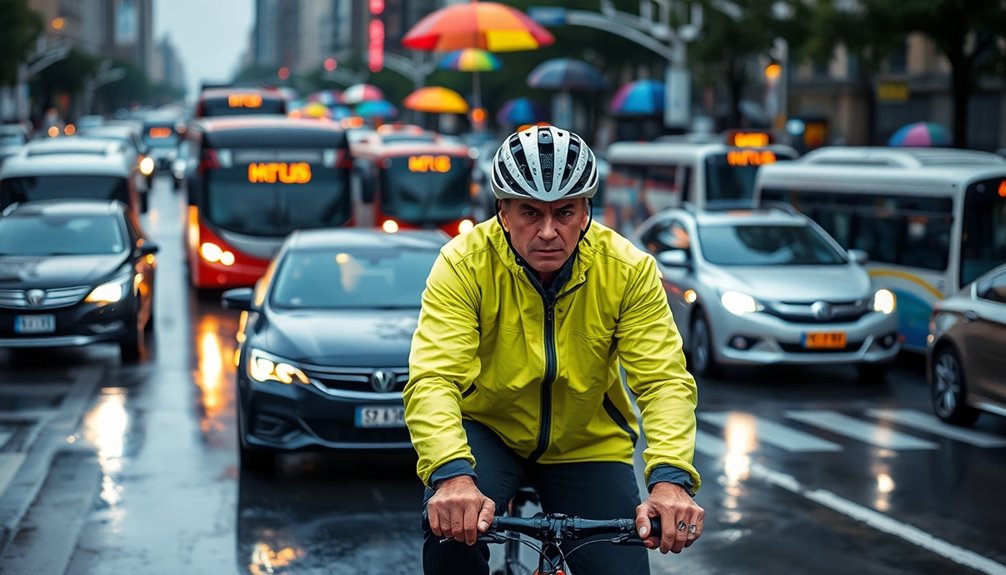
Cycling in urban environments requires more than just good etiquette; it also demands adaptability to varying weather conditions.
In rainy weather, wear waterproof gear and use lights to enhance visibility, while reducing your speed on slippery roads.
For hot days, stay hydrated and wear lightweight clothing to manage your body temperature.
If it's windy, plan routes with natural windbreaks to maintain stability and control.
Always check weather forecasts and consider using route apps to avoid hazardous conditions.
When faced with high humidity or extreme temperatures, aim for early morning or late evening rides for comfort. Additionally, be aware of dreaming during sleep cycles, as good rest is essential for alertness while cycling.
Navigating Intersections Safely
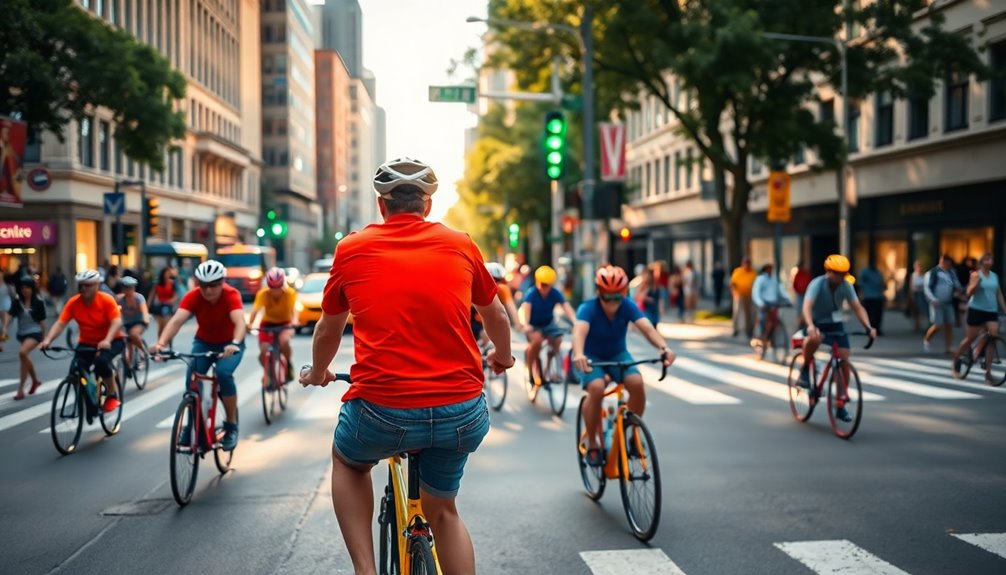
As you approach an intersection, being aware of your surroundings is crucial for your safety.
Adjust your lane position based on your intended direction and make eye contact with drivers to ensure visibility. Always signal your intentions clearly to other road users.
Keep an eye on traffic and scan left, center, and right before crossing. Remember to yield to pedestrians and vehicles already in the intersection.
Manage your speed, maintaining a steady pace to avoid startling drivers. In high-volume areas, look for protected intersections or phased signals that enhance safety.
Finally, stay prepared for unexpected situations, always ready to stop if necessary. Your awareness and predictability can significantly reduce the risk of accidents.
Utilizing Bike Lanes and Paths

When you take advantage of bike lanes and paths, you not only enhance your safety but also contribute to a more bike-friendly urban environment.
Protected bike lanes can reduce road fatalities by 44% and serious injuries by 50%. By using these lanes, you'll find they significantly decrease the chances of injury for all road users and encourage more people to cycle—cities like New York saw a 75% increase in bike usage in their first year.
These lanes also help control turning conflicts and reduce speeding, making your rides smoother. Plus, wider, segregated lanes minimize hazards like parked cars and open doors.
Enhancing Visibility and Communication
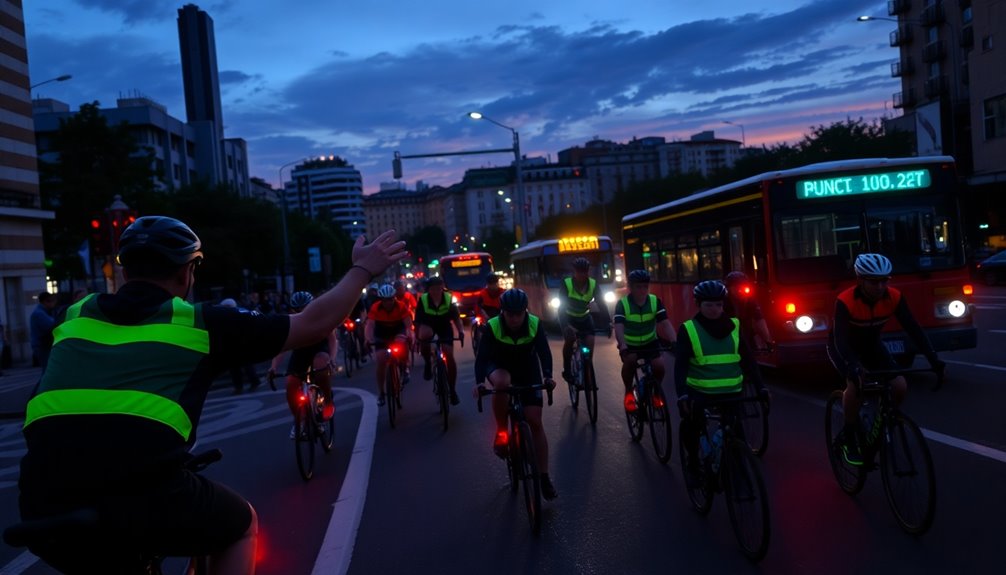
Visibility and communication are crucial for safely navigating urban roads, especially in bustling environments where distractions abound.
To enhance your visibility, wear high-visibility clothing during the day and reflective gear at night. Equip your bike with front and rear lights, ideally flashing, and add reflective strips to your helmet and accessories. Position yourself confidently in the lane to avoid blind spots, particularly near large vehicles.
For effective communication, use clear hand signals to indicate your intentions and follow traffic rules to maintain predictability. Signal early to give drivers time to react, and keep a consistent position on the road.
Utilizing technology like helmet-mounted lights and LED strips can further boost your visibility, making your ride safer and more secure. Additionally, investing in home security systems can provide peace of mind while you park your bike in urban areas.
Frequently Asked Questions
What Are the Best Types of Bikes for City Commuting?
When choosing the best bike for city commuting, consider your needs.
City bikes offer comfort and stability for urban environments, while hybrid bikes balance speed and comfort.
If space is tight, folding bikes are perfect for portability.
For longer commutes or hilly areas, electric bikes provide that extra boost.
Make sure to look for features like durability, storage options, and comfort to ensure your ride is enjoyable and efficient.
How Can I Improve My Cycling Fitness for Urban Riding?
Imagine your legs as pistons, powering through city streets. To improve your cycling fitness, mix interval training with long rides, building strength and endurance like a sculptor chiseling a masterpiece.
Incorporate hill repetitions and practice pedaling into headwinds to forge resilience. Ensure your bike fits you like a glove, and use clip-in pedals for efficiency.
What Should I Do if I Get a Flat Tire?
If you get a flat tire, start by finding a safe spot to pull over.
Completely deflate the tire and inspect it for punctures. Use a water or soap test to identify leaks.
Depending on the damage, either patch the tube or replace it with a spare.
Reinstall the tube carefully, reinflate it to the recommended pressure, and check for leaks again before getting back on the road.
Always carry essential tools for emergencies.
Are There Any Cycling Apps for Navigation and Safety?
If you're looking for the ultimate cycling companion, navigation apps are like having a personal tour guide on two wheels!
Apps like Bikemap and Komoot offer extensive route options tailored to your ride style, while Google Maps provides basic bike directions.
For safety, Flare detects incidents and alerts your emergency contacts.
With features like real-time updates and crowd-sourced data, these apps ensure you stay safe and on track during your rides.
How Can I Advocate for Better Cycling Infrastructure in My City?
To advocate for better cycling infrastructure in your city, start by building coalitions with local advocacy groups.
Engage your community through events and inclusive rides to foster trust.
Use data to highlight the benefits of bike-friendly infrastructure, focusing on broader societal impacts.
Support policies like Complete Streets to enhance road safety.
Lastly, involve community members in planning and ensure equitable distribution of resources across neighborhoods to address everyone's needs.
Conclusion
As you navigate the bustling city streets, remember that cycling isn't just about speed; it's a dance with traffic. Like a skilled conductor leading an orchestra, you need to harmonize with your surroundings, using your gear, knowledge of the law, and awareness to create a symphony of safety. Embrace the rhythm of urban cycling, and you'll not only survive the ride but enjoy the journey—turning the chaos of the city into a seamless flow of adventure.


